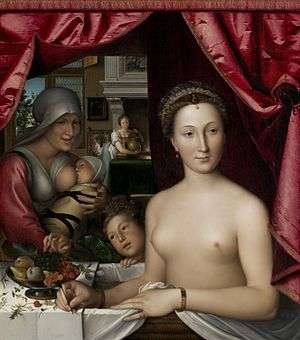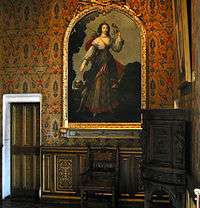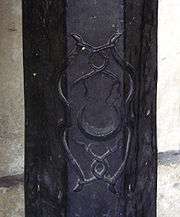Diane de Poitiers
Diane de Poitiers (9 January 1500 – 25 April 1566) was a French noblewoman and a prominent courtier at the courts of kings Francis I and Henry II.
Diane de Poitiers | |
|---|---|
 | |
| Born | 9 January 1500[1] Château de Saint-Vallier, Saint-Vallier, Drôme |
| Died | 25 April 1566 (aged 66) |
| Burial place | Château d'Anet, Anet, Eure-et-Loir |
| Title | The Grand Senechal(e) of Normandy Countess of Saint-Vallier Duchess of Étampes Duchess of Valentinois |
| Spouse(s) | Louis de Brézé, Seigneur d'Anet |
| Children | Françoise de Brézé Louise de Brézé |
| Parent(s) | Jean de Poitiers, Seigneur de Saint Vallier Jeanne de Batarnay |
She wielded much influence and power at the French court as King Henry's chief mistress. She continued in this role until Henry was mortally wounded in a tournament accident. During that tournament his lance wore her favour (ribbon), rather than his wife's.
Diane is subject of paintings by François Clouet as well other anonymous painters. She was also immortalised in a statue by Jean Goujon.
Early life
Diane was the daughter of Jean de Poitiers, Seigneur de Saint Vallier and Jeanne de Batarnay.[1] When still a girl, she was briefly in the retinue of Anne de Beaujeu,[2] eldest sister of King Charles VIII, a capable and highly intelligent woman who held the regency of France during his minority.[2]
Diane was educated according to the principles of Renaissance humanism, in music, hunting, manners, languages, the art of conversation, and dancing. She learned how to read Latin and Greek, and became a keen hunter and sportswoman,[2] remaining in good physical condition well into middle age.
Marriage
At the age of 15, Diane was married to Louis de Brézé, seigneur d'Anet, who was 39 years her senior.[2] He was a grandson of King Charles VII[3] who served as a courtier of King Francis I. They had two daughters:
- Françoise de Brézé (1518–1574)[4]
- Louise de Brézé (1521–1577)[5]
In 1524 her father Jean was accused of treason as an accomplice of the rebellious Connétable de Bourbon.[5] His death sentence was commuted but he was confined to prison until the Treaty of Madrid in 1526.[5]
When Diane's husband died in 1531 in Anet,[5] Diane adopted the habit of wearing black and white, her personal trademark for the rest of her life.[6] They were among the permitted colours of mourning, which, as a widow, she was required to wear, but they were also the symbolic colours of the bright and dark sides of the moon. They played on her name, Diane, which derived from Diana, the name of the Roman moon goddess.
Diane's keen interest in financial matters and legal acumen became apparent for the first time during this period. She retained her late husband's emoluments as governor and grand-sénéchal of Normandy, assuming herself the title of "sénéchale de Normandie". She challenged in court the obligation to return her husband's appanages to the royal domain. King Francis I allowed the widowed Diane to keep and manage her inherited estates independently, without the supervision of a male guardian.
While Louis de Brézé was still alive, Diane became lady-in-waiting to Queen Claude of France.[7] After the queen died, she served in the same capacity to Louise of Savoy[3] and then Eleanor of Austria.
Royal favourite

After the capture of Francis I by Charles V's troops during the battle of Pavia (1525), the two eldest princes, Francis and Henry, were retained as hostages in Spain in exchange for their father. Because the ransom was not paid in time, the two boys (eight and seven at the time) had to spend nearly four years isolated in a bleak castle, facing an uncertain future. Henry found solace by reading the knight-errantry tale Amadis de Gaula. The experience may account for the strong impression that Diane made on him, as the very embodiment of the ideal gentlewomen he read about in Amadis. As his mother was already dead, Diane gave him the farewell kiss when he was sent to Spain.[8] At the tournament held for the coronation of Francis's new wife, Eleanor of Austria, in 1531, while the Dauphin of France saluted the new queen as expected, Henry addressed his salute to Diane.[8]
In 1533, Henry married Catherine de' Medici.[9] There had been opposition to the alliance, the Medicis being no more than upstarts in the eyes of many in the French court. Diane, however, approved of the choice of bride.[10] Diane and Catherine were actually related, their grandmothers being sisters.[11] As the future royal couple remained childless, concerned by rumours of a possible repudiation of a queen that she had in control, Diane made sure that Henry's visits to his wife's bedroom would be frequent.[12] In another act of preservation of the royal family, Diane helped nurse Catherine back to health when she was ill.[13] Until 1551, Diane was in charge of the education of her and Henry's children,[14] whose governor and governess Jean d'Humières and Françoise d'Humières,[15] took their orders from her; her daughter Françoise managed the queen's household as her chief lady-in-waiting or Première dame d'honneur. While Henry and Catherine would eventually produce 10 children together, and despite the occasional affair with such as Philippa Duci, Janet Fleming, and Nicole de Savigny, Diane de Poitiers would remain Henry's lifelong companion. For the next 25 years, she would be the most powerful influence in his life and the most powerful woman in France.[16] Based on allusions in their correspondence, it is generally believed that she became his mistress in 1534, when she was 35 years old and Henry was 15.[17]

A noted beauty, she maintained her good looks well into her fifties, and her appearance was immortalized in sculpture and paintings.[18] Only two signed paintings by François Clouet are known to exist, one being a painting of Diane (or Mary, Queen of Scots according to other scholars) as a teenager. The subject of that painting shows her as a teenager seated nude in her bath. She sat for other paintings of the time, often topless or nude, other times in traditional poses.
In about 1549, an unknown artist (formerly believed to be Jean Goujon) designed a statue especially for her in which she represented the goddess Diana. It features her reclining nude body together with her two dogs and a stag and was entitled "Fountain of Diana". It is displayed in the Louvre.[19]
When Francis I was still alive, Diane had to compete at the court with Anne de Pisseleu, the king's favourite. After Francis' death, his son Henry II had Anne banned from government and confiscated the duchy of Estampes.[16]
Diane had a sharp intellect and was so politically astute that King Henry II trusted her to write many of his official letters, and they even signed them jointly with the one name HenriDiane. Her confident maturity and loyalty to Henry made her his most dependable ally in the court. Her position in the Court was such that when Pope Paul III sent the new Queen Catherine the "Golden Rose", he did not forget to present the royal mistress, Diane, with a pearl necklace. Within a very short stretch of time she wielded considerable power within the realm. In 1548, she received the prestigious title of Duchess of Valentinois, and in 1553, she was made Duchesse d'Étampes. The king's adoration for Diane caused a great deal of jealousy on the part of Queen Catherine, particularly when Henry entrusted Diane with the Crown Jewels of France, had the Château d'Anet remodelled for her, and gave her the Château de Chenonceau, a piece of royal property that Catherine had wanted for herself. However, as long as the king lived, the Queen was powerless to change that.
Henry's death and her downfall


Despite wielding such power over the king, Diane's status depended on the king's welfare and remaining in power. In 1559, when Henry was critically wounded in a jousting tournament, Queen Catherine assumed control, restricting access to him. Although the king was alleged to have called out repeatedly for Diane, she was never summoned or admitted, and after his death, she was also not invited to the funeral. Immediately thereafter, Diane was obliged to give to Catherine the Château de Chenonceau, the jewel of the Loire Renaissance palaces, in exchange for Catherine's Château de Chaumont. Diane stayed there only a short time, and she lived out her remaining years in her château in Anet, Eure-et-Loir, where she lived in comfortable obscurity as a virtual exile.[20]
At the age of 64, Diane suffered a fall during a ride.[18] Never fully recovering, she died at the age of 66.[18] In accordance with her wishes and to provide a resting place for her, her daughter completed the funeral chapel, built near the castle. During the French Revolution, her tomb was opened, her corpse desecrated, and her remains thrown into a mass grave. In 1866, Georges Guiffrey published her correspondence.
When French experts dug up the remains of Diane de Poitiers in 2009, they found high levels of gold in her hair. It is suggested that the "drinkable gold" that she "reportedly" regularly took, believed to preserve youth, may have ultimately killed her.[21][22][23][24] In May 2010, she was reburied at her original tomb in the Château d'Anet.
In popular culture

Diane de Poitiers has been featured in many novels and films.
Novels
- The Two Dianas, by Alexandre Dumas, père
- Courtesan, by Diane Haeger
- La Princesse de Clèves, by Madame de La Fayette
- The Devil's Queen: A Novel of Catherine de Medici, by Jeanne Kalogridis
- Queen's Play and Checkmate, by Dorothy Dunnett
- The Master of All Desires, by Judith Merkle Riley
- Mary Queen of Scots: A Scottish Queen's Diary, France 1553, by Kathryn Lasky
- The Wild Queen: The Days and Nights of Mary, Queen of Scots, by Carolyn Meyer
- The Confessions of Catherine de Medici, by C.W. Gortner
- Royal Road to Fotheringhay and Madame Serpent, by Jean Plaidy
- The Serpent and the Moon, Princess Michael of Kent (remote descendant of Diane de Poitiers)
- The Ruling Passion, by Alice Acland
- Rival Queens, The Betrayal of Mary, Queen of Scots, by Kate Williams Kate Williams (historian)
Films
- Diane (1956), portrayed by Lana Turner
- Nostradamus (1994), portrayed by Diana Quick[25]
Television
- Reign (2013), portrayed by Anna Walton
References
- Wellman 2013, p. 189.
- Wellman 2013, p. 190.
- Wellman 2013, p. 191.
- Carroll 1998, p. 20.
- Wellman 2013, p. 192.
- Wellman 2013, p. 193.
- Brown 2010, p. 128.
- Wellman 2013, p. 197.
- Baumgartner 1988, p. 28.
- Wellman 2013, p. 198.
- Wellman 2013, p. 194.
- Wellman 2013, p. 200.
- Baumgartner 1988, p. 98.
- Carroll 2009, p. 55.
- Knecht 2016, p. 4-5.
- Wellman 2013, p. 203.
- Wellman 2013, p. 199.
- Wellman 2013, p. 214.
- "Fountain of Diana". Louvre. Retrieved 1 September 2018.
- Wellman 2013, p. 213.
- "Henry II’s mistress returned to rightful resting place", May 31, 2010, The Sunday Times
- Charlier, Philippe; Poupon, Joel (2009), "Fatal Alchemy" (PDF), British Medical Journal, 339: 1402–1403, retrieved 29 May 2016
- Charlier P; Poupon J; Huynh-Charlier I; Saliège JF; Favier D; Keyser C; Ludes B (2009), "A gold elixir of youth in the 16th century French court", British Medical Journal, 339: b5311, doi:10.1136/bmj.b5311, PMID 20015897
- ḎḤWTY. "A Mistress with the Midas Touch: Her Hunger for Gold Would Be the Death of Her". Ancient Origins. Retrieved 13 April 2018.
- "Nostradamus (1994)". Internet Movie Database. Retrieved 31 July 2012.
Sources
- Baumgartner, Frederic J. (1988). Henry II: King of France 1547–1559. Duke University Press.CS1 maint: ref=harv (link)
- Brown, Cynthia Jane, ed. (2010). The Cultural and Political Legacy of Anne de Bretagne: Negotiating. D.S. Brewer.CS1 maint: ref=harv (link)
- Carroll, Stuart (1998). Noble Power During the French Wars of Religion: The Guise Affinity and the Catholic Cause in Normandy. Cambridge University Press.CS1 maint: ref=harv (link)
- Carroll, Stuart (2009). Martyrs and Murderers: The Guise Family and the Making of Europe. Oxford University Press.CS1 maint: ref=harv (link)
- Knecht, R.J. (2016). Hero or Tyrant? Henry III, King of France, 1574-89. Routledge.CS1 maint: ref=harv (link)
- Wellman, Kathleen (2013). Queens and Mistresses of Renaissance France. Yale University Press.CS1 maint: ref=harv (link)
Further reading
- Beck, Shari (2011). A Portrait in Black and White: Diane de Poitiers in Her Own Words. Bloomington IN USA: iUniverse. ISBN 978-1-4620-2983-9.
- Cartland, Barbara (1962). Diane de Poitiers. Hutchinson.
- Cloulas, Ivan. (1997). Diane de Poitiers. Fayard. ISBN 978-2213598130 (in French)
- Le Fur, Didier (2017). Diane de Poitiers (in French). Paris: Perrin. ISBN 978-2-262-06784-7.
External links
| Wikimedia Commons has media related to Diane de Poitiers. |